1. Q1 Asset Class Performance Summary-Bespoke Investment Group

https://media.bespokepremium.com/uploads/2021/04/033121-ETF-MatrixQ11.png
Continue reading
https://media.bespokepremium.com/uploads/2021/04/033121-ETF-MatrixQ11.png
Continue readingRegardless of investment style, dividends have made a significant contribution to the long-term total return of U.S. large-cap equities.

BMO Global Asset Dividend contributions to large-cap total returns | BMO Global Asset Management (bmogam.com)
Continue readingJason Goepfert–From Dean…With the air coming out of some of the more speculative pockets of the market, now is an excellent time to remember the following thought…with great reward comes significant risk.
With IPO, SPAC, Solar, and other speculative stocks down on a peak to trough basis of greater than 20%, let’s see how that compares to the technology bubble in the mid to late 1990s.
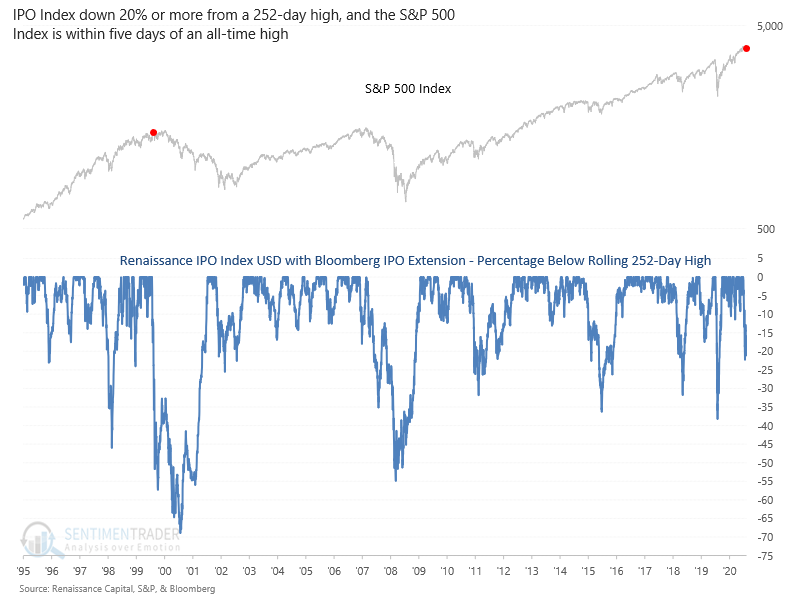
The Renaissance IPO index closed down more than 20% from its most recent high last week even as the S&P 500 was less than five days from a new all-time high. As the chart above shows, this is the second instance in history. With n=2, this isn’t to make any dire predictions; it’s merely an observation.
From Packy McCormick Not Boring Blog

Equities: Public pensions are heavily overweight equities
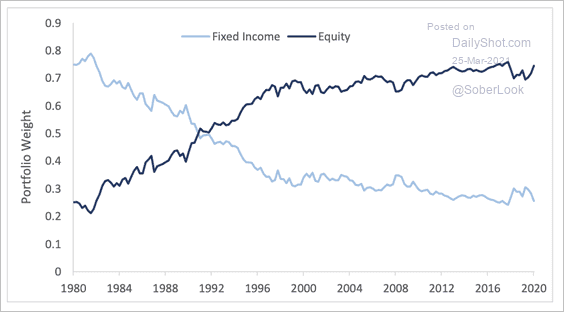 Source: Deutsche Bank Research
Source: Deutsche Bank Research
Rates: The long-bond selloff looks overextended.
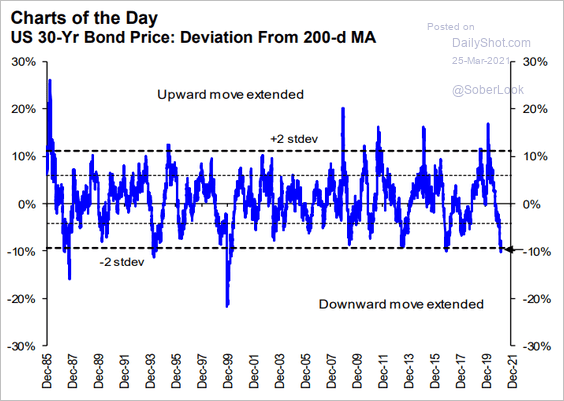 Source: Hugo Ste-Marie, Portfolio & Quantitative Strategy Global Equity Research, Scotia Capital
Source: Hugo Ste-Marie, Portfolio & Quantitative Strategy Global Equity Research, Scotia Capital
The Daily Shot
https://dailyshotbrief.com/the-daily-shot-brief-march-25th-2021/
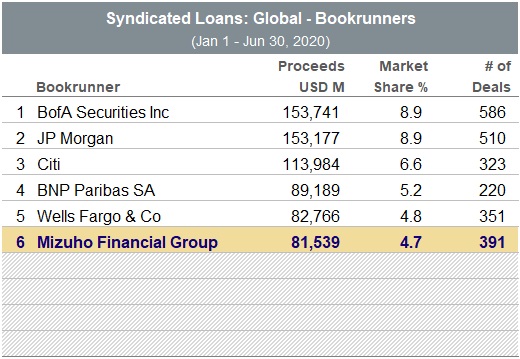
Global Syndicated Loans
Source: Refinitiv, Global Syndicated Loans Review
https://www.mizuhogroup.com/bank/what-we-do/syndicated_finance
Business and Non-Business Bankruptcies Fall as the U.S. Government becomes buyer of last resort.

https://www.uscourts.gov/news/2021/01/28/annual-bankruptcy-filings-fall-297-percent
Wolf Street –Need a used pickup truck? Forget it. Or pay out of your nose for it. Prices across the major categories have exploded – but amid these price spikes, pickup truck prices stand out with a stunning bang-your-head-against-the-wall price spike of 43%.
Maybe buy a new truck instead? Well, in theory. In reality, inventories of new pickups are tight and are now also tangled up in semiconductor shortages that have caused assembly plants to cut production.
But even in categories that Americans have long pooh-poohed and spurned, auction prices soared, up 15.9% for mid-sized cars up by 10.5% for compact cars:
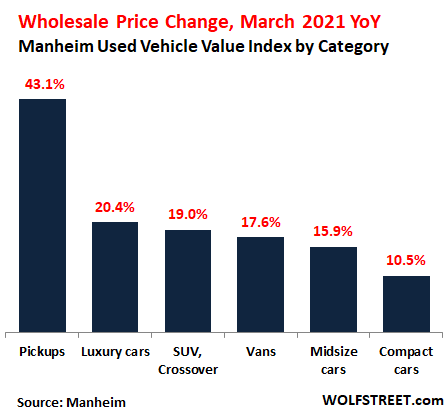
What’s Behind the Stunning Spike in Used Vehicle Auction Prices? By Wolf Richter for WOLF STREET.
As it is, clean energy jobs by the end of 2019 were already outpacing fossil fuel jobs by a ratio of nearly 3 to 1 (3.36 million to 1.19 million), while clean energy employment grew at a 10.4% pace between 2015 and 2019, well ahead of the 6.1% growth in total employment. And the federal Bureau of Labor Statistics forecasts two of the top three fastest -growing occupations from 2019 to 2029 will be wind turbine service technicians and solar panel installers.
A Successful Green New Deal Will Need Private Partnersby Scott Minerd of Guggenheim Investments, 3/26/21

https://www.irena.org/-/media/Files/IRENA/Agency/Publication/2020/Sep/IRENA_RE_Jobs_2020.pdf
Advisor Perspectives BLOG
by Frank Holmes of U.S. Global Investors, 3/26/21
For the past 20 years, the Port of Los Angeles has been the busiest seaport in the Western Hemisphere, responsible for exporting commodities such as soybeans and raw cotton and importing everything from furniture to electronics. In 2020, container volume reached 9.2 million 20-foot equivalent units (TEUs), with total cargo handled valued at $259 billion.
Last month, the Port of L.A. saw an incredible 47% increase in container traffic compared to February 2020, representing the strongest February in its 114-year history. The port processed nearly 800,000 TEUs during the month, marking the seventh straight month of year-over-year growth.

Beware, home buyers: A record number of homes are selling above their asking price-By
The competition in the real-estate market now underscores the need to build more homes, Fairweather argued. “America needs an audacious goal to increase the housing supply, given the U.S. is short 2.5 million homes,” she said. “It may be expensive to build millions of homes, but ignoring the problem would only cause housing to become more unaffordable and worsen housing insecurity.”
Redfin’s research echoed the findings of other real-estate economists. A recent report from Realtor.com found that the total inventory of active home listings was down 52% from a year ago.
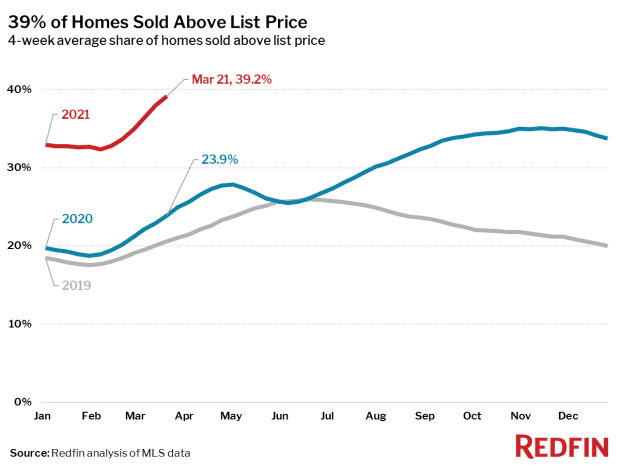
Countries in China’s Belt and Road Initiative: Who’s In And Who’s Out
Blog Post by David Sacks
Jennifer Hillman and David Sacks are codirectors of the CFR-sponsored Independent Task Force report on a U.S. Response to China’s Belt and Road Initiative, which is co-chaired by Jacob J. Lew and Gary Roughead.
In the fall of 2013, shortly after assuming power, Chinese President Xi Jinping proposed building a land-based “Silk Road Economic Belt,” extending from China to Central and South Asia, the Middle East, and Europe, and a sea-based “21st Century Maritime Silk Road,” connecting China to Southeast Asia, the Middle East, Africa, and Europe via major sea lanes.Belt and Road Initiative
Together, these came to form the Belt and Road Initiative (BRI), still known officially in Chinese as “One Belt, One Road,” which quickly became Xi’s signature foreign policy undertaking. Under BRI, Chinese banks and companies seek to fund and build roads, power plants, ports, railways, 5G networks, and fiber-optic cables around the world.
BRI has a wide reach, but which countries are participants? The answer is surprisingly hard to determine, since China is opaque about the exact contours of BRI and there are different levels of participation in the initiative. But our CFR Independent Task Force report outlines what we were able to discover about the participating countries in BRI.
https://www.cfr.org/blog/countries-chinas-belt-and-road-initiative-whos-and-whos-out

The right amount of hormesis can help to bulletproof your body and mind
Everyone knows that much the world has been on lockdown for the last several months, first with the 2-month goal of “flattening the curve,” but now it’s morphed into “lockdown until there’s a vaccine.”
Whether a functional and safe vaccine emerges or not, you are most likely going to be dealing with this virus, and the thousands of others you deal with every winter, for the long term. If you don’t believe me, here are a few other notable people who agree:
If that sounds scary, know that there are four other coronavirus strains that are endemic and cause many cases of the common cold. There are strategies available to manage your own biology that make you more resilient and less susceptible to all kinds of infections. I used to be the guy who got sick constantly, but now it’s exceedingly rare.
Knowing how to upgrade your immune system so you can get sick less is important because the psychological impact of coronavirus could be worse than COVID-19 itself. According to projections by the Well Being Trust, the despair from the current situation could contribute to between 27,644 – 154,037 deaths.[1] Stress is an epidemic in and of itself, but no one is talking about how to flatten the mental health curve.
The good news is that if you read this blog, you are already looking for ways to Bulletproof your stress response system and be more resilient, no matter what the world brings to your door. You’ve read about ways you can protect yourself from the negative impacts of bad stress in this post. Here, you’re going to learn about the role of hormesis in mitigating stress and improving stress resilience, ultimately boosting the immune system. And since gyms and fitness centers are still closed or with limited offerings, what are the best biohacks we can do at home? This is all about resilience! (Nothing written here is a treatment or cure for anything, especially a virus.)
What is hormesis?
Hormesis is a fancy word for “what doesn’t kill you, makes you stronger.” The devil is in the details, however, because for stress to have a beneficial effect (improved health, stress tolerance, growth, or longevity), you have to control the timing and dose of stressors. The real definition of hormesis should be, “What doesn’t kill you or weaken you, makes you stronger.”
Our bodies are made to toughen up with hormeses such as heat, sun, cold, physical activity, and even famine. These things can hurt you at high intensity or for prolonged durations, but in small, hormetic doses, they make you stronger by stimulating an adaptive response and rejuvenating cellular processes. Research suggests that these responses help you live longer, reduce oxidative stress, improve your immune system, and boost your mood.
They are core biohacking techniques to become more resilient, and the good news is that you can do them at home even under lockdown.
Light it up
Using an infrared sauna is one of the best investments of your time because you can do it at the same time as other useful things! Within a 30 – 40 minute session, you can meditate and unwind, read, listen to Bulletproof Radio, or even take calls, all while getting the well-studied hormetic benefits of heat.
It can even help mentally. A 2016 clinical trial published in JAMA Psychiatry found that gentle infrared heat on the skin that increased core body temperature helped with mild to moderate depression in unmedicated patients. A single session of whole-body heat helped with depression within a week, and the effect lasted over six weeks.[2]
Dr. Charles Raison, MD, the lead author of this study, believes that increasing core body temperature and gentle skin heating help correct the neuronal miscommunications that contribute to depression. Also, the gentle and soothing warmth has similar effects to a hug, by increasing serotonin and oxytocin.[3]
For years, I have recommended and used Sunlighten saunas to increase my resilience. They effectively increase my core body temperature and gently heat my skin. Their Solocarbon heater produces far infrared waves, peaking at 9.4 microns, which is most compatible with human physiology.
Because infrared heat’s your body from the inside versus heating the surrounding air, you still sweat – a LOT – but at a much lower and comfortable temperature than an old fashioned dry sauna. Overheating the skin, such as with higher intensity of shorter-wavelength infrared spectrum, can diminish the mood-enhancing effects.[3]
It’s going to be a while before most psychiatrists start prescribing infrared saunas, but it’s worth considering because saunas have significantly fewer side effects than antidepressants. So if you’re feeling down during social distancing, spending some of that time in an infrared sauna is a great way to improve your mood and maybe even mental health.
During this government-mandated travel lockdown and lack of playdates for my kids, I’ve spent most mornings with my 11-year-old son in our Sunlighten sauna. It’s a great time to bond. We read from Ryan Holiday’s The Daily Stoic, and talk about how to be resilient. We aren’t alone – Dr. Caroline Leaf, a hard-charging cognitive neuroscientist, and mental health expert say she also uses her Sunlighten sauna daily to destress and improve her mental health.[4]
Then there’s sleep, which helps you be more resilient physically and mentally. Infrared therapy supports the immune system by improving sleep quality.[7] Sleep supports your immune function.
There are also physical hormetic benefits. I wanted highly emissive heaters and the correct spectrum, which is why I selected the Sunlighten sauna – 99% emissivity Solocarbon heaters and the 9.5 nm peak frequency. Regular sauna use can strengthen your immune system, similar to a fever. [5] The heat also stimulates heat-shock proteins (HSP) and antioxidants, which helps the immune system fight off viruses and reduces your risk of getting sick.[6]
HSPs are really important for your resilience. Your body makes them after you expose yourself to almost any kind of external stress, including exercise. HSPs (from sauna or exercise):
I use my Sunlighten sauna regularly because it’s the least painful way to turn on those HSP benefits. I also use intense exercise, blood flow restriction, hypoxia, ozone therapy/oxidative stress, and fasting, which are documented to do the same thing to HSP. It’s just that spending 30 minutes in my sauna to raise HSP is more relaxing and more fun!
Chill out
Immersing yourself with ice-cold water or sub-zero temperatures in a whole body cryotherapy chamber might sound like torture. But it works. Once you become cold-adapted, cold therapy actually invigorates your mood, cognitive function, and makes you healthier.[9][10] If you are new to cold therapy, it is important to gradually build up to it rather than jumping into an ice bath the first time. Becoming cold-adapted activates the vagus nerve, boosting your relaxation response and strengthening the nervous system against stress.[11] You’ve probably heard Wim Hof’s interview on Bulletproof Radio where he shows how he has used cold (and breathing) to completely stop immune system inflammation, even when he intentionally injected himself with a bacterial toxin!
Cold therapy is a type of hormesis that reduces inflammation and increases cellular antioxidants.[12][13] Although many people associate being cold with getting sick, repeated but brief cold exposure strengthens your immune system in the long run.[14] Cold exposure also helps improve insulin sensitivity,[15] which also helps with weight loss and overall health.
Because temperature fluctuations activate heat-shock proteins, hot-cold therapy (alternating between a hot sauna session and cold exposure) can be a great synergy. Many studies support the benefit of hot-cold therapy for exercise recovery because it can better clear inflammation from tissues than either heat or cold alone.[16] Alternating between a hot sauna and a cold shower also allows you to tolerate more heat and cold during each cycle, thus reaping more hormetic benefits. The good news is that a 1 minute cold shower, for just three days in a row, has the power to change cardiolipin in your mitochondrial membrane, as I wrote about in Super Human.
CRITICALLY IMPORTANT: Keep your cold exposures brief (and ideally follow with a sauna or a hot shower). Some people make the mistake of believing that since some cold is good, colder must be better. Getting truly chilled or being over-exposed to cold for long periods of time increases your risk of respiratory infection!
This is one reason I’m adding a Sunlighten sauna at the new Upgrade Labs location in Victoria, BC when it opens. I will suggest that members use it right after our liquid-nitrogen fueled cryotherapy sessions.
Take a breath
Breathing exercises are free, on-demand mind control. Traditions throughout the world have developed and used breathing exercises as part of their meditative or healing practices.
There are a variety of breathing patterns that can help you achieve the desired mental states, improve your stress resilience, or stimulate healing responses in your body. Mindfulness breathing helps you focus, whereas Pranayama breathing can help you calm down. Dr. Andrew Weil, MD, developed the 4-7-8 breathing, a type of Pranayama breathing that quells the nighttime monkey mind for a good night’s sleep. He shared it during his interview on Bulletproof Radio. Wim Hof breathing, before cold exposure, involves controlled hyperventilation before breath-holding to strengthen your nervous system and stress response. It also makes cold not hurt!
Breath-holding patterns are also a form of hormesis that makes your lungs stronger. In small doses, it slightly increases oxidative stress in the airway, making you more resilient and boosting your airway antioxidant levels.[17] In Head Strong, I talk about brief oxygen deprivation called Intermittent Hypoxia, which I use at Upgrade Labs to help clients raise HSP and stimulate neurons to create more mitochondria.
In the spirit of stacking my biohacks, I sometimes do breathing exercises inside my sauna. Since both can raise HSP, doing them at the same time makes a lot of sense!
Fast(ing) food
Intermittent fasting, a core part of the Bulletproof Diet since 2011, and the topic of my upcoming book Fast This Way is the practice of eating during a shortened window of time. Fasting of any type combats insulin resistance and obesity.
Since obesity and insulin resistance significantly increase the risk of complications and death for any illness (including COVID-19), start doing it now. Fasting also improves brain function and protects the brain in stressful situations.[18] Third, it stimulates autophagy or cellular self-cleaning, which rejuvenates your cells and may help with cellular defense against viruses.[19] And yes, it increases HSP – just like my infrared sauna.
During this pandemic, Dr. Peter Attia, one of the early guests on Bulletproof Radio, recommends against extended fasts of over two days because it can spike cortisol and dampen the immune system, making you more susceptible to infections.[20] However, shorter fasts like a restricted daily eating window are still beneficial.
CRITICALLY IMPORTANT: Fasting is a stressor on the body. If you’re exhausted and stressed, or menstruating, try intermittent fasting every other day. You can over-exercise, and you can over-fast. Both of them will reduce your immune function!
To learn how to fast without hunger and pain, check out Fast This Way. It also includes a section on heat and cold exposure. For instance, I recommend doing your infrared sauna session towards the end of an intermittent fast, which helps it to liberate stored glycogen from your cells.

Get some sun
One of the first three posts on this blog 10 years ago was about the importance of sun exposure, and a lot more research has come out since then. Most people still fear the sun because the sunscreen industry has a big incentive to emphasize that sun exposure damages the skin and causes skin cancers.
They are right. Too much sun exposure does exactly that, and so do sunburns. A logical person would conclude that, if some sun exposure is bad, you should minimize it.
That’s a bad idea too. A 2017 Swedish study found that sun avoidance is linked to all-cause mortality. [21] While too much sun increases the incidence of skin cancers, the correct dose of sunlight reduces your risk of all other types of cancers. The key driver of sun-related skin cancers is sunburn, but sun exposure at hormesis doses (avoiding sunburns) greatly exceeds the risk.
Vitamin D is crucial during this pandemic because it protects against respiratory tract infections. [22] Most people can’t raise their vitamin D levels enough from sun exposure alone without also damaging their skin. The best strategy is to get a blood test of your Vitamin D3 levels and take enough vitamin D to get your levels to about 70-90 ng/ml. Because of genetics, you may require a lot more, or a lot less, than other people. For instance, despite my white skin, I require about 15,000 IU of vitamin D3. That’s nearly 3x the average amount someone my weight would need.
However, taking Vitamin D3 is only part of the problem. You simply must also expose your skin and eyes to sunlight in order to activate the D3 from your supplements via a process called sulfation.
Hormetic doses (about 20-30 minutes) of the sun’s full-spectrum light affects your physiology far beyond vitamin D, here’s how:
You don’t need to become a leather-skinned sun worshipper to get a hormetic dose of sunshine. Use these tips to get just the right dose and avoid damage:
Infrared light is one of the most relaxing and beneficial spectrums of sunlight. If you cannot get consistent and optimal infrared from daily sun exposure, either because you live in a Northern climate, or because it’s winter, or because your government forbids you to go outside (note: I can’t believe I even typed that sentence.), there is still hope.
You can reap similar hormetic benefits with an infrared sauna, without the skin aging from UV rays. Combined with vitamin D supplementation, infrared saunas can boost protective nitric oxide production, trigger autophagy, boost mood, and improve sleep quality. As I mentioned earlier, Sunlighten saunas contain the most beneficial infrared wavelengths, with far, mid, and near-infrared, which is why it’s what I use at home.
Mix and Match
If this article was too much info for you, it’s ok. Just do at least one of the things you read about here. These biohacks each boost mitochondria, improve mental health and increase immune function. You do get more mileage when you stack them together.
For example, a breathing practice can powerfully combine with heat or cold exposure. Wim Hof breathing coupled with cold exposure is a great synergy to invigorate your mind early in the day. It also boosts your cognitive function and stimulates your vagus nerve. Then, workout or go for a social walk outside during the day to get sun.
In the evening, end your day with meditative breathing while relaxing in an infrared sauna. My Sunlighten Sauna even has a targeted infrared spectrum for relaxation, designed to boost happiness and love neurotransmitters. Better yet, invite your partner to the sauna with you. After all, it’s traditional to use your sauna naked… 🙂
What biohacks are you using at home during this time?
https://daveasprey.com/heat-cold-light-and-what-to-skip-to-keep-your-immune-system-strong/
Lansing Street Advisors is a registered investment adviser with the State of Pennsylvania..
To the extent that content includes references to securities, those references do not constitute an offer or solicitation to buy, sell or hold such security as information is provided for educational purposes only. Articles should not be considered investment advice and the information contain within should not be relied upon in assessing whether or not to invest in any securities or asset classes mentioned. Articles have been prepared without regard to the individual financial circumstances and objectives of persons who receive it. Securities discussed may not be suitable for all investors. Please keep in mind that a company’s past financial performance, including the performance of its share price, does not guarantee future results.
Material compiled by Lansing Street Advisors is based on publicly available data at the time of compilation. Lansing Street Advisors makes no warranties or representation of any kind relating to the accuracy, completeness or timeliness of the data and shall not have liability for any damages of any kind relating to the use such data.
Material for market review represents an assessment of the market environment at a specific point in time and is not intended to be a forecast of future events, or a guarantee of future results.
Indices that may be included herein are unmanaged indices and one cannot directly invest in an index. Index returns do not reflect the impact of any management fees, transaction costs or expenses. The index information included herein is for illustrative purposes only.
Netflx and Amazon only FAANG stocks exponentially above S&P index P/E

Capital Group Blog https://www.capitalgroup.com/advisor/insights/articles/big-tech-big-trouble.html
Continue reading